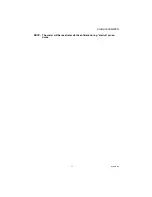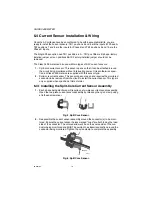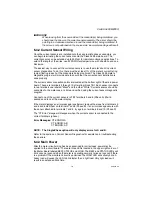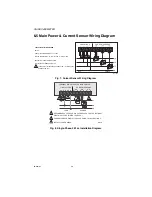
CLASS 3400 METER
19
62-0391-03
IMPORTANT:
When looking from the source side of the conductor(s) being monitored, you
should see the arrow on the current sensor assembly. The arrow should be
pointing in a clockwise direction around the conductor(s) being monitored. If
the arrow is not positioned on the source side, inaccurate readings will result.
6.4.2 Current Sensor Wiring
Once the current sensors are installed onto their appropriate phase conductors, you
can begin terminating the current sensors onto the Class 3400 main board. The
current sensors can be extended up to 500 feet for remote monitoring applications. To
extend the length of the wires, use #22 AWG twisted-pair wire with one white and one
black wire.
The easiest way to connect the current sensors is to use the meter’s built-in current
sensor diagnostics. To do this, there must be at least 1% of the meter’s current rating
(amps) flowing in each of the conductors being monitored. The Class 3400 meter’s
diagnostic program will provide data to ensure that the current sensor installation is
done properly.
The current sensor connection points are located at the bottom right of the main power
board. These are terminals 5 through 10 of terminal block TB1. Each sensor connects
to two terminals one labeled “Black” and the other “White.” Current sensors should be
connected to the meter one at a time and verified using the current sensor diagnostic
program.
Connect one of the current sensors to TB1 terminals 5 and 6 (Phase A). Wait 5
seconds and look at the meter display.
If the meter displays an error message (see below), remove the wires from terminals 5
and 6 and install them on terminals 7 and 8 (Phase B). if an error message occurs with
the sensor attached to terminals 7 and 8, try again on terminals 9 and 10 (Phase C).
The “CT Error:“msage will disappear when the current sensor is connected to the
correct terminals (phase).
Error Messages:
CT ERROR: A
CT ERROR: A B
CT ERROR: A C
NOTE: The Single-Phase option will only display errors for A and B.
Refer to the section on Current Sensor Diagnostics for assistance in troubleshooting
these errors.
6.4.3 Main Power
After the meter circuit wiring has been examined for correctness, power may be
applied to the circuit board. There are three LEDs located in the upper right corner of
the Meter Board labeled BEAT, STATUS and LOAD. The BEAT and STATUS LEDs will
blink once per second when the meter is operating normally, twice per second if there
is a problem.If the monitored circuit is under load the LOAD LED will actively blink. A
heavy load will cause the LED to blink faster than a light load. Very light loads will
result in an extended blink time.


































